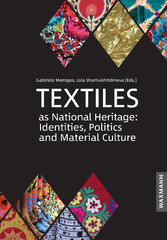Suchen und Finden
Service
Book Cover
1
Imprint
4
Acknowledgements
5
Contents
7
Introductory Remarks (Gabriele Mentges)
9
Decolonizing Heritage
12
Narratives of the Silk Road: Uzbekistan
14
Textile Heritage and National Identity
19
Crafts in Motion
21
Signifying Identity
21
Consumption Scapes: Bazaars and Other Shopping Sites
22
Performing Cultural Heritage
23
Bibliography
25
Between Design, ‘National Dress’ and Nation Branding. The Dynamics of Textile Culture in the Process of Uzbek National Formation (Gabriele Mentges)
31
Textile Cultures Now and Then
31
Performing textile traditions
35
National Dress
39
Uzbek wedding rituals and their impact on gender constellations
41
The Material of Tradition
47
Traditional Dress: A Hidden Fashion Discourse?
49
National Fashion and Textile Design
52
Nation-State, Fashion and Self-Orientalization
58
Bibliography
61
Fashionable Roots. Textile Heritage in Contemporary Fashion Design in Peru (Susana Aguirre)
67
Introduction
67
Peru’s Fashion Industry
69
Fashioning Peruvianness
72
Designer Meche Correa
73
Brand: Escudo
78
Designer: Naty Muñoz
82
Conclusion
85
Bibliography
85
Textile Tradition in Kazakh Contemporary Fashion (Gulnar Soltanbayeva)
89
Textile Heritage
90
Designing Kazakh Tradition
93
Bibliography
100
The State of Textile Arts in Today’s Kazakhstan (Ardak Yussupova)
103
Of Dyes and Colors. Cultural Change in Uzbek Textile Crafts (Melanie Krebs)
119
Natural dyes of Central Asia
122
The emergence of synthetic dyes
127
Re-inventing natural dyes after independence
130
Conclusion
133
The Rehabilitation of Khon-Atlas (Lola Shamukhitdinova)
137
Introduction
137
Technologies and the Historical Agenda of Khon-atlas
137
Dress Practices and Style
140
Does Khon-atlas Have a Future?
147
Bibliography
149
Sources
150
Uzbek Skullcaps. A Popular Headwear between Traditional High Quality and Touristic Souvenir (Lola Shamukhitdinova)
153
A Brief History of Central Asian Skullcaps
154
The Skullcap as Brand
158
Making the Skullcap Fashionable
159
Skullcaps and Their Changing Significance
165
The Skullcap as a “Cultural Resource”
167
The Issue of Quality: Some Recommendations
169
Conclusion
173
Bibliography
174
Tuskiiz – A Cultural Memory of the Kazakhs (Zhazira Zhukenova)
179
Artistic and Aesthetic Content
179
Unique Technical Features of Tuskiiz Using Appliqué
180
Tuskiiz Using Chain Stitch
181
Figurative and Symbolic Meaning
183
Tuskiiz Using Appliqué
183
Tuskiiz Using Chain Stitch
184
Bibliography
185
A Mosaic Picture of the World. A Close-up on Kazakh Kurak Patchwork (Gaini Mukhtarova)
187
Kazakhstani Traditions and Rites Associated with the Art of Kurak
187
Patchwork as a Way of Passing on Qualities and Protecting against Evil Spirits
192
The History of the Emergence of Kurak Patchwork
194
Special Features of the Kazakh Kurak
195
Kurak as the Philosophy of a Mosaic Picture of the World
199
Modern Uses of the Kurak Technique
200
Bibliography
202
Bazaars, Shops, Malls. Points of Sale and their Meaning for Textile Culture in Uzbekistan (Gabriele Mentges and Lola Shamukhitdinova)
205
Research on Bazaars
206
The Bazaar in Central Asian Cities
208
Structure and Organization
214
To shop – But how and where?
215
Who they are – the dealers/tradesmen
216
The Bazaar and Tourism
217
Contemporary transformations
219
Old Central stores: ZUM and GUM
222
Cities and Bazaars: An Outlook to the Future
223
Bibliography
225
Istanbul Markets. A Reloading Point for Uzbek Craft Textiles (Gabriele Mentges and Lola Shamukhitdinova)
229
Silk Road – Central Asia – Uzbekistan? The Collections of the Linden-Museum in Stuttgart: Evaluation and Interpretation in the Time of Emerging Nation-States of the Post-Soviet Era (Annette Krämer)
239
Introduction
239
The Origins of the Linden-Museum and its Central Asian Collections
239
Friedrich Kussmaul, Iran and Afghanistan: A New Focus
243
The “State Museum,” the Orient Department and the Discovery of “Turkestan” and “Turkmens”
246
Discovering “Uzbekistan:” the 1990s
255
“Uzbek Textiles” in Stuttgart – An Outlook
264
Bibliography
266
Safeguarding Uzbek Textile Crafts. Strategies and Impacts (Binafsha Nodir)
269
What Does the Term ‘Traditional Uzbek Textiles’ Cover?
270
Weaving
272
Embroidery
274
Traditional Crafts in the Context of Colonial Modernization
278
Strategies and the Revival of Traditional Uzbek Textiles
279
Museum Collections as a Source of the Traditional Arts Revival
284
Bibliography
290
A Repository of Mediterranean Memories. How a Ritual Dress Has Become a UNESCO Cultural Heritage of Humanity (Leyla Belkaïd-Neri)
293
A Complex Vestimentary Heritage
293
Facing Political Disinterest in Dress Culture
294
The Unprompted Roots of a Social Phenomenon
296
The Awakening of Governmental Authorities
298
Selection Criteria
299
A Repository of Mediterranean Memories
301
Negotiating Identity through the Rediscovery of Vernacular Styles
306
Bibliography
308
Complete Bibliography
309
Authors
321
Alle Preise verstehen sich inklusive der gesetzlichen MwSt.








